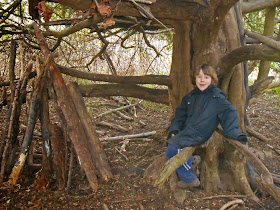Daffs in the Obs wildlife garden
Dog Violets and Speedwell around the obs
Common Quakers- got a new actinic bulb and caught more moths last night- three Common Quakers and an Agonopterix Alstromeriana.
Hazel- winter catkins coincidiing with the spring flowers
Hopefully last of the winter storms have passed- a very old Beech up rooted in Banstead Woods
Nephew Sid in the Woods
Looks like it's going to be an early spring. A few observations in the local Hackbridge/Beddington Farmlands area recently including:
Plants/shrubs in flower (roughly chronologically): Snowdrops, Crocus, Daffodil, Dog Violet, Speedwell, Forsythia, Cherry Plum, Ornamental cherry variety also wild plants flowering include Groundsel, Red-dead Nettle, Daisy and lots of Charlock on the farmlands mounds.
Trees in leaf: Hawthorn, Elder
Went to a reception in town yesterday with the World Land Trust. Met John Burton (CEO of World Land Trust) and Renton Righelato who were old Beddington boys from the 1950's. John went to school with Peter Grant and they did the farm together in the days when there were 5000+ Snipe in the flooded fields (which became flooded again recently due to the record breaking winter rainfall- its the first time the old irrigation pipes and dykes have been flowing with water since the 1960's) .



































